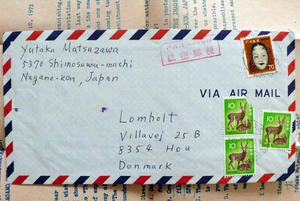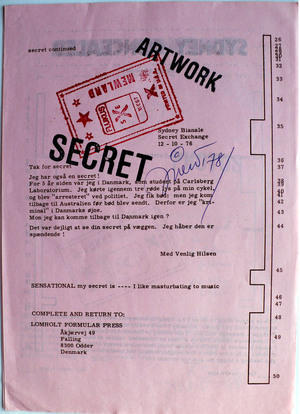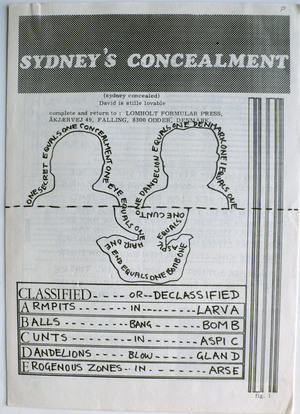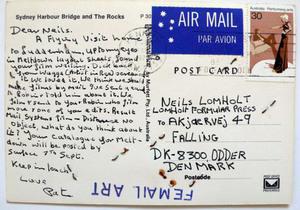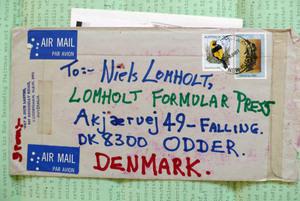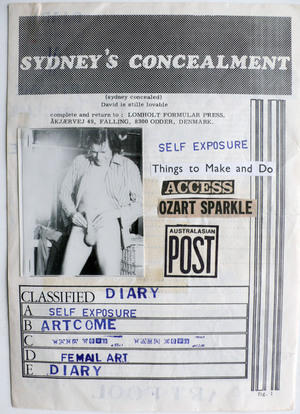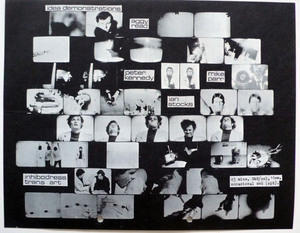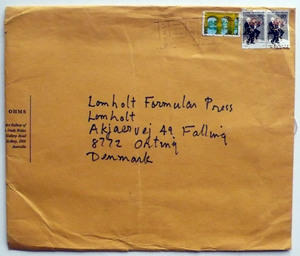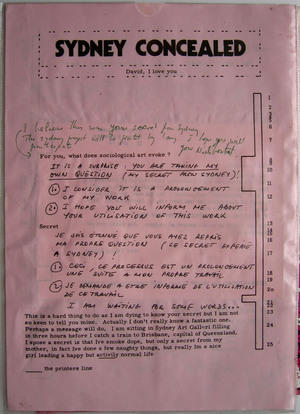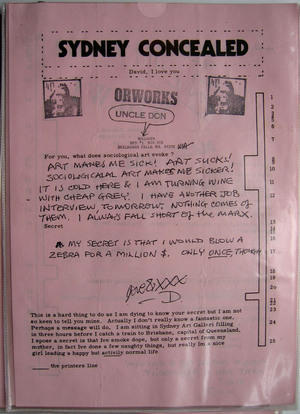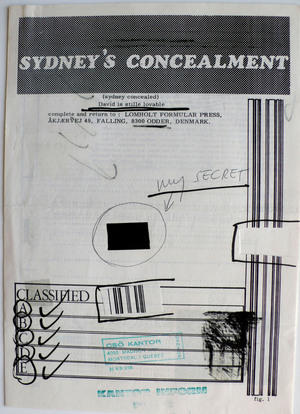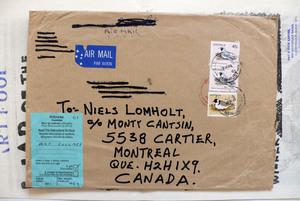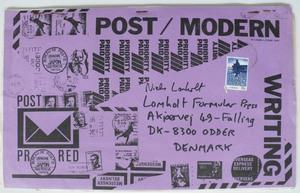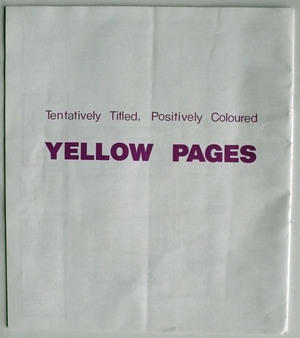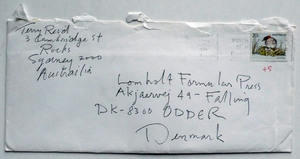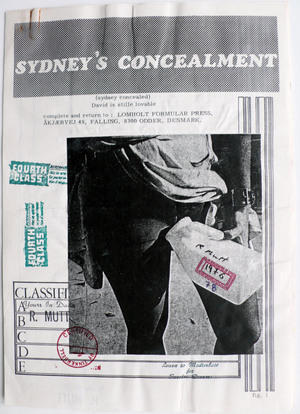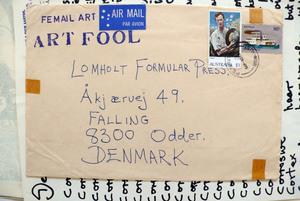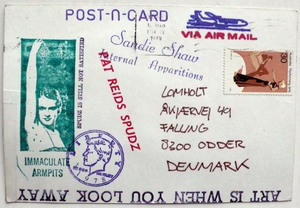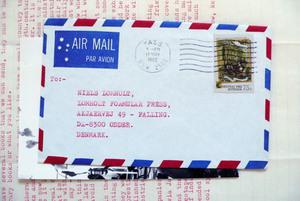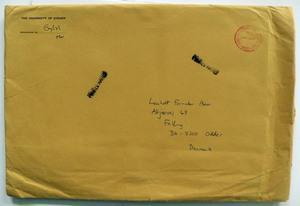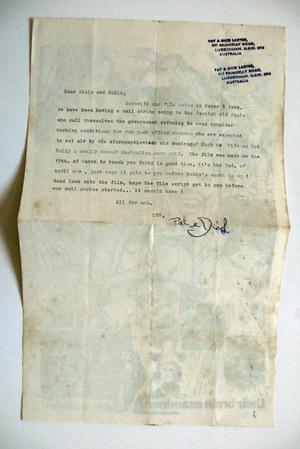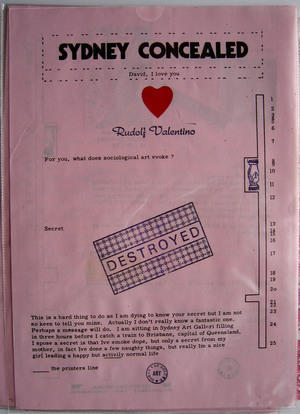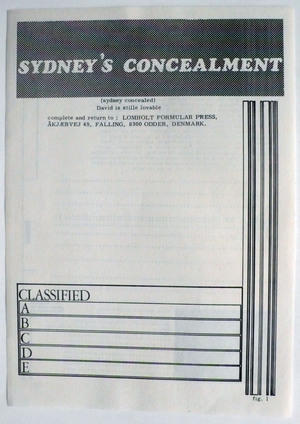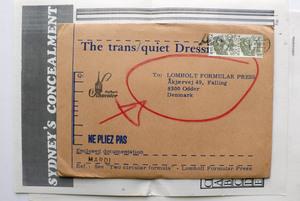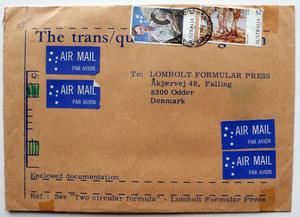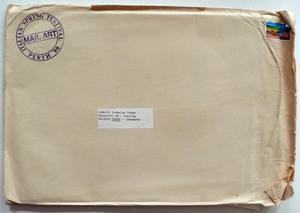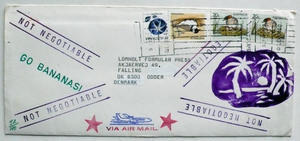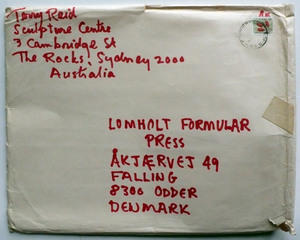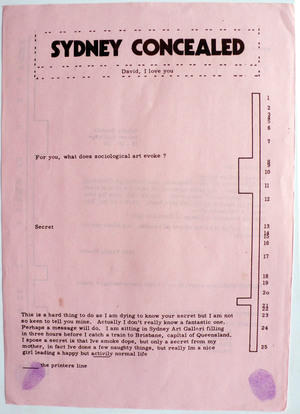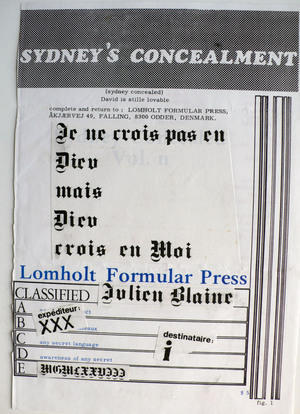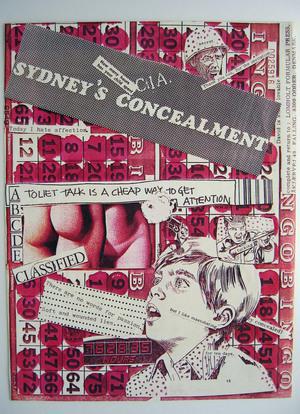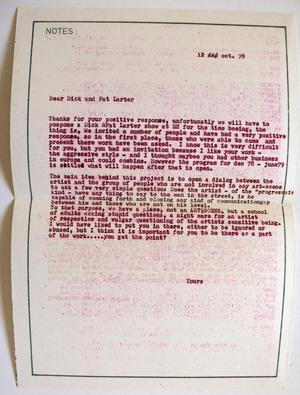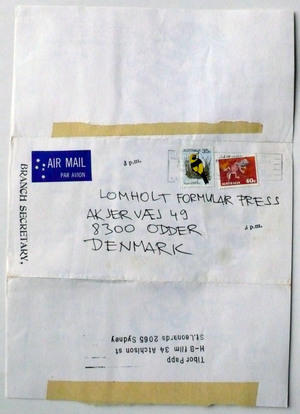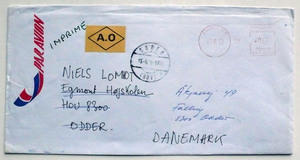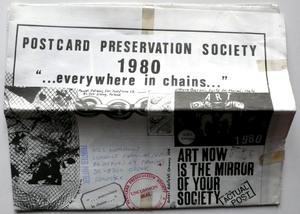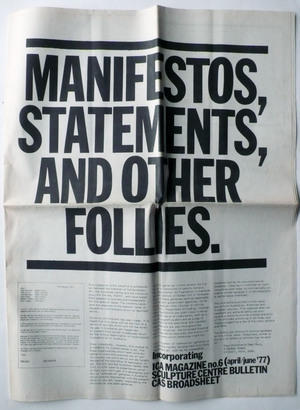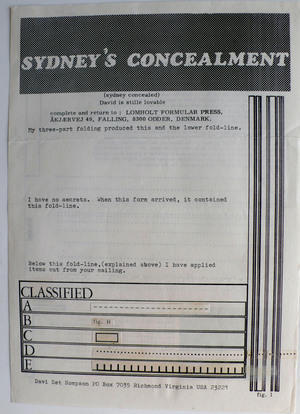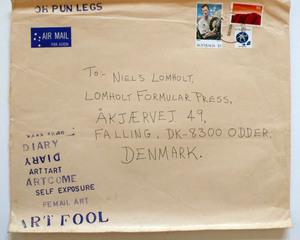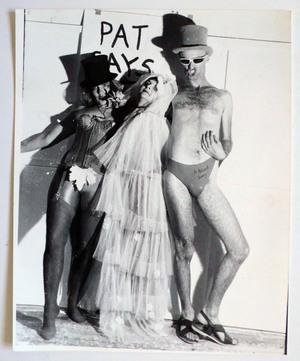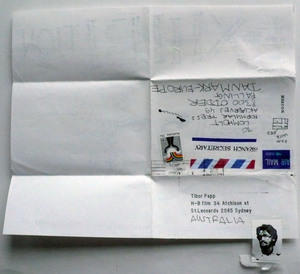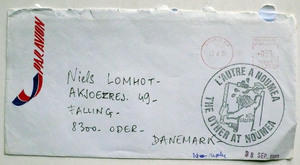In the FORMULAR
By Terry Reid or not
DECEMBER 2012 - JANUARY 2013
a1 ] As a quick look into the LOMHOLT FORMULAR ARCHIVE reveals, the archive is the accumulated result of the activity of Niels Lomholt for over a decade and a half from the beginning of the 1970s. It is the observation of human interaction, most broadly observed in the sections dealing with the tumbling, rambunctiously precarious world of Art in the Mail. I say precarious because of Mail Art’s ephemeral situation, made ephemeral because it largely resides outside the protecting confines of our historicizing institution, the museum. Not much temperature and humidity control, or white-glove handling for most Mail Art works. Like love letters in the sand when the tide goes out and the sand dries, the smallest gust can blow them away.
(Consolidated Power, or was that Powder?)
a2 ] On occasion, an institution does take interest, does collect samples. Over the decades, these occasions add up; but, to date, there is as yet no adequate or central record of what is there or where it resides. If a record existed, an examination of Mail Art’s far-flung archived parts would make an incomplete jigsaw of broadly divergent exchanges. The research would reveal a Doctor Frankenstein haphazard body of dis-united parts. Of the institutions that have collected Mail, made as a vehicle for communication by artists with incredibly varied purposes, most have acquired (or retained from exhibitions) the work, usually a paper work on postcard or in envelope, sometimes a publication, frequently enough a tape, DVD, etc, in its original form Ωπ∑≥ α∞β. The works are then shut away in acid-free archival boxes (e.g. Dick Higgins or Jean Brown papers at Getty Research Institute; Lucy Lippard papers at the Smithsonian; the John Held Jr collection of Mail Art periodicals at MoMA library). Various institutions give varying degrees of access. Access may not be easy.
a3 ] A problem that Niels Lomholt observed is that this process is a kind of funeral – a last rites as Mail is lowered into the burial chamber, only to be, on rare occasion, visited by a historian researching details of the Mail Art phenomenon.
a4 ] A solution to this limitation has been the decision of the Museet for Samtidskunst (Museum of Contemporary Art) in Roskilde, Denmark to instead put this Archive online. It takes the art out of the (archival) box and into your lap(top): dormant artwork from an old century gets new life in the young millennium – a likely inspiration for fresh work from young artists. New work is best when it knows (shows) the history from whence it sprung. (For history see Ruud Janssen of IUoMA.org in Mail Art Statements ebook; or collective history in artist Crackerjack Kid‘s published anthology, "Eternal Network".)
a5 ] So what is the Niels LOMHOLT FORMULAR project? And just what is a FORMULAR? The word has a figurative versatility that allows it to reform for the various purposes of captivating and framing. In the case of Mail Art, think of many streams coursing through an ocean of activity: The FORMULAR can be readily perceived as a net-like device which has been dipped into the ocean to withdraw samples of that activity. The particulars of these samplings provided the studies that constitute the early, individually published project papers of the FORMULAR PRESS.
a6 ] This writing that you are now reading is the result of yet another dip of the FORMULAR, taking new direction as it takes a further small-step-large, moon-walking into CyberSpace:
a7 ] FORMULAR PRESS: Why did Terry Reid from Canada journey over to Japan, to Australia .... a restless soul??? Who did you meet on this journey? Were you working in any other art fields, concrete poetry, photo, film etc .... ??
a8 ] No. I am not at all restless. In fact, I am the world’s slowest traveller. It takes me so long to go home, by then there is never a home left to go to.
a9 ] Often, it has been projects that have taken me elsewhere. Not specifically so, Japan. In 1969, I had a grant option for an open-ended return-ticket to anywhere in the world. I had already spent time in Jamaica and Trinidad which triggered a consciousness of what would have been my otherwise unperceived engagement with first world culture. That engagement meant Kathmandu was off my list (too medieval), Japan was on. Japan provided me the biggest culture-jump available without having to abandon the twentieth century (for the three years from early1970 to late 1972).
a10 ] Of course, everything is translatable into Mail .... (and translatable out of Mail), but, yes, I work across possibilities in areas other than Mail. Three of my larger Japan projects include "sky drawing", an aerial drawing using a 500 metre roll of silver Mylar hoisted high by hydrogen balloons and wind (Tokyo Harbour 1971 w/Taiji Arita + team); and, for the introductory exhibition D.I.Y. of the Video Hiroba group, the installation-performance-video production of "six-pack of cokes", wherein the pouring of the first coke activates the first in a bank of six monitors, thereby televising the first pour, pouring of the second coke activating the second monitor which is replicated on two monitors, and so on (Sony Building, Ginza 1972 w/Michael Goldberg, Taiji Arita + team); and making "fire on the crests of waves" as they crashed on the shore-line (Kamikura Kanagawa Prefecture 1972, assisted by Haruhide Murata and Michael Goldberg, in illustration of a Brenn Robertson concept wherein the expanses of earth, air and water are demarcated on a conjoining shore with a line of fire).
a11 ] Japan’s first video exhibition D.I.Y., (Do It Yourself) it should be noted, was also the initiation and beginning of the group Video Hiroba by Fujiko Nakaya (EAT (Experiments in Art and Technology)), Michael Goldberg (EAT) and sculptor Yamaguchi Katsuhiro. It led to the establishment of a video network within Japan which connects globally. From that exhibition, work continues to the present with Fujiko Nakaya continuing to provide video archiving at the former Video Gallery Scan under the project name ProcessArt.
a12 ] I was also all-the-while ОЎЍЋ doing Mail. During this period, I had met Taii Ashizawa, whose multi-directional art-world friendships included the senior and respected Yutaka Matsuzawa (at MoMA in NYC) (in the Lomholt archive in Denmark). Matsuzawa’s connections were wide, reaching throughout Japan and into conceptual art networks outside Japan. These Japanese artists maintained contact through regular exhibitions (and attendant meetings) at various centres around and outside Japan. Exhibitions were organized by (and consisted of) mail: however, little of this mail would be identifiable within the conventions of Mail Art. Their sources were not founded in Dada and its sister Surrealism, but were deeply Japanese. There was none-the-less some interest in going international both within and externally to this group. As an evangelizer of Mail, an evangelizer of communication and contact really, I would get translations for exhibition calls (calls for contributions), adding Japanese translations to English calls, adding English translations to Japanese calls and further circulate them by mail.
a13 ] In 1972, a show co-organized (at the behest of Ashizawa) with Kunimasa Kuriyama culminated in a large east meets west exhibition of mail (and etceteras) in Tokyo at the Tokiwa Gallery (google Recycle + Tokiwa Gallery). It could be described as a meeting of the twain.
a14 ] You mentioned home. Long before the three year mark of living in Tokyo, I had cashed in my return air-ticket home. The money from this was spent actualizing the "fire on water" project described above.
a15 ] So how was I subsequently able to do the infamous BeaNZ Caper half a globe away in New Zealand (National Art Gallery w/the inspired assistance of Ian Hunter)? Beanz** was a performance that incidentally included outgoing mail and incoming telegrammes, with documentation left entirely to fortuitous responses by public media. I was close to broke, but I had been made a personal offer of a one-way ticket on a P&O liner out of Yokohama, followed by a flight from Sydney to Auckland. And here the tale moves back from travel and the many splendored fields of art toward our more central issue of Mail. New Zealand was an easy place to get a job, but an impossible place to get a job that paid much money. The positive side was that, if you did not desire imported luxuries, it also cost nothing much to live. The logic was persuasive: stay and do an art-from-everywhere project. Wasn’t this how I kept in contact with people *OOOOO OOOOOOO*in the places I had been and made contact with people in places I was yet to go?
a16 ] In Auckland, I had lucked a chance meeting with artist Bob Kerr. Bob, who was studying at Elam, pasted-up the student tabloid for the University of Auckland. What if we produce a broadsheet in daily news format? Ken Friedman had effectively used the idea of square inches in an exhibition on a sheet of paper which circulated as a letter. What if we use the inch idea, make the inch multi-dimensional, and assemble two-dimensional contributions or photos of three dimensional contributions into the column inches of a newspaper? With Bob’s skills on hand, we launched a broadsheet under the title "Inch Art Issue", and, in the process, subverted the iconic and corner-stone image of the daily newspaper for the purposes of art.
a17 ] Subverting images from the dominant culture (e.g. Life magazine, in the hands of artists, became File magazine, which was further subverted to Vile magazine, etc) thus diverts high powered energy into the artwork, while defusing the authority of the original – a phenomena not yet fully exploited, nor yet given the critical reflection it warrants.
a18 ] The Inch Art endeavour of Mail and etc was done in a genre-specific medium, done only as a broadsheet daily-style newspaper. To Bob’s chagrin, we did not take on the obvious possibility of also showing the actual inch works in a real-space exhibition.
a19 ] Within a couple of years, Nick Spill (aka Nick Nice), working with Luit Bieringa, then of the Manawatu Art Gallery, made up for our oversight by organizing an immense showing, titled Art in the Mail. Art in the Mail travelled from public gallery to public gallery throughout New Zealand. The journey continued when then gallery director, Tom McCullough organized a subsequent tour for it in Australia.
a20 ] I mention this because, aside from Denis Mizzi‘s report of an American travelling tsunami of a show, backed by Lucy Lippard, in opposition to the Vietnam war, "Art in the Mail", despite being put together in one of the world’s smallest countries, was likely the biggest, longest running and furthest travelling show in the history of Mail Art. Ed Varney also has done some heavy hitting in this regard, despite the disadvantage of not having the backing of substantial institutional budgets. Of course, a show of Mail Art does not have to have backing. It does not even have to have a roof. Like graffiti, it can be shown anywhere. It can also travel in your pocket and be displayed to the people you are with at a café. Or, if preferred, it can be viewed in the privacy of your own home.
a21 ] In the 70s in the southern hemisphere, the next thing in bigness after the São Paulo Biennale was the Mildura Triennial, a prime difference being that the São Paulo Biennale occurred in what then was a city of 9,600,000 while Mildura was a river town with a mere 12,000 people. The setting was not city but country, and most visiting artists camped by the river. Late night campfire conversations in a relaxed setting meant easy exchange. Camaraderie, for an often fractious artworld, was strong.
a22 ] Invited through then expat UK artist Ti Parks for the Triennial, Bob Kerr and I produced a second broadsheet, "The Mildura Papers", this time combining first-hand coverage of the enormous artfest with the long-distance reports of Mail Artists. The intent was two-fold: to create within the publication an interface between the deformalizing of Mail and the redefining of sculpture in both its modern and postmodern forms (results were awkward). We also wanted to support the politics of this unique and effective town & country endeavour with the hope of encouraging others, not just to ship work across, but to personally cross the Tasman Sea from New Zealand (or elsewhere) for the actual contact that we had found so worthwhile. This proved to be our greatest success: for subsequent Triennial exhibitions and the Biennale of Sydney, people did come and in great numbers (achieved through the work of Nick Spill, Ian Hunter, Tom McCullough and others).
a23 ] The Mildura Arts Centre in 1976 provided the opportunity to test run the "Mask/Show", a fluxus idea and an oppositional juxtaposition - to Mask is to hide, to Show is to reveal - it was open to the participation of all. Again it was hoped that a melding could be achieved, joining local township participation with national (the Centre had a deserved level of national fame) with the international through Mail and my personal networks. "The Mask Ompendium", a book of masks resulting from the show was applauded by fluxus founder *George Maciunas** and by Jean Brown of The Tyringham Institute (location then for the Leonard M Brown Memorial Collections of Dada and Surrealism (and other twentieth century movements)). Click here to download Geoff Tennant drawing down a mask on Terry Reid.
a24 ] Later that year, I was able to initiate the "SYDNEY SECRET EXCHANGE" (along with an international artists directory, the "positively coloured, tentatively titled Yellow Pages") at the Biennale of Sydney; this triggered the first of two interconnections with the LOMHOLT FORMULAR PRESS in parallel but hidden universes (see the Lomholt FORMULAR SYDNEY CONCEALED). Ken Friedman had turned the idea of exhibition, Mail or otherwise, on its head with the show "Omaha Flow Systems". In Omaha, the exhibition itself had been destabilized by making the exhibits exchangeable with items brought into the gallery by visitors. Ideas of the privileged object or of the museum representing ongoing certainties were eliminated – a radical destabilization of norms. This was fluxus. To the mix, I would add the factor that art, contained in envelopes, cannot be seen: an exhibition of hidden art - unless visitors committed a secret to paper and exchanged, in envelopes, a secret for a secret. An envelope, in the normal course of events, of course, is public without, private within.
(Note) Formular archival images from the "Secret Exchange": see Nick Spill, secret of art; secrets of Quoz?magazine, in the Archive and lost in Cyberspace (google Quoz? mail art magazine RealityStudio).
(Note) Formular record of the Yellow Pages: a backward glance at the front cover; Argentinean + Australian; Canadians, Danes + the English; Nick Spill smacks his llips (sic) from Hungary to Turkey; et al & et cet.
(Also Note) the Quoz? image later reappears as a component in a Dick Larter composite. This sort of quoting, and quoting of quotes (parrots singing from the same page) is found continuously throughout the Mail Movement (a term which I think Dick Larter coined to distinguish a broad flourishing of activity beyond that around Ray Johnson).
NOVEMBER 2013: interjection from Niels Lomholt to Terry Reid
Hi, Terry,
b25 ] It is time for the next move. To make the connection between your great text and my archive. Our touching points are "Sydney Secret Exchange", "Artists Yellow Pages" and "Art Core Meltdown". I’ll send a CD with the files I have on these projects. I would be greatful (sic) if you could comment on these files, talk about the artists, the shows, their reception, or what comes to mind.
If you could comment on Pat Larter and Richard Larter, I would be very greatful (sic), I’ll include the Larter files on the CD.
JANUARY 2014: reply from Terry to Niels
Hi Niels,
b26 ] Thanks for your note. And thanks for the CD with your art files. Looking through the files, I see we have touching points on another few additional projects during that same time period – "Foreighn Ingredients" (sic) and "3WEEKSinAUGUST" (Dragan Ilic's "Electronic Pencils", w/Amanda Harcourt). Both "Ingredients" and "3weeks" occurred under the auspices of the Sculpture Centre, which freed exhibitions from the commercial imperative. You also have a copy of "MANIFESTOS, STATEMENTS and OTHER FOLLIES", an attempt done with Paul McGillick to write the future of art (Do any attempts succeed?). "Foreighn Ingredients", more in the present than "Manifestos", focused on the art activities and delinquencies of Blaster Al Ackerman and his wife Patty* (a found illustration, re-assigned by Ackerman), Eerie Billy Haddock (below Mike Parr’s burning leg, gave the Ackerman illustration a further re-assignment), roller-derby girl, Rhodda Mappo, Tom Musicmaster Cassidy and their friends (represented here by name, as is David Zack in the Ackerman/Haddock images). The title for the show, with its mis-spelling, was taken by me from a typographic mis-typing of an enthusiastically unapologetic, error-prone** Al Ackerman (not his real name, they say).
(* Typical of the form, photos that Patty Ackerman takes of Blaster Al are re-circulated in a Formular request that the Larters post back to Niels Lomholt. Just what belongs to whom in this world of mailart?)
(** Ackerman in an erroneous fit of cleanliness, reads poetry with a bar of soap in the mouth, as opposed to reading poetry without a bar of soap in the mouth.
(Note) IUoMA post humous tribute page to Al Ackerman)
b27 ] Cess Franke (aka Spudz) was, at the time, in Portland, helping to post material extensively designed to challenge every expectation of normalcy. While one Sydney reviewer, William Pidgeon described them as The Portland Iconoclasts ... who post ... contemporary visuals and think-pieces all over the world, another, Nancy Borlase, described the work as This scruffy looking show, in which each exhibit seems hardly worth the price of an airmail stamp, (it) is one of the non-events of the year.
b28 ] The 2D material that arrived for the gallery walls was well-met by the Larter family and cohorts who conducted a welcoming performance for opening night. Dick played ringmaster, Pat was a bare-breasted French Maid serving the audience a tray of marzipan genitals representing a variety of sexes. A Larter performer, Neil Stevenson (or was it Eben Sterling?), who had a large Chinese brush as a penis, painted out messages to the interpreting/encouraging/provoking notes of music group, Currents. The event was videoed by Stephen Jones and Sue Lord.
b29 ] The reviewer, Nancy Borlase was wrong. This was not a non-event. It would be easier to write-off Conceptual Art as last year’s avant garde had done. This, on the other hand, had something to offend everyone. Even artists reacted against it. But then, artists, more than most, establish territories they are compelled to defend. Like war, Culture Wars are just another form of territorial wrangling between people; in the case of Nancy, she was a warrior for the establishment, which is harder to stop than a vampire (and these are the keyboarding fingers of experience speaking).
(Note) By 1979, the aforementioned Cees (Spudz) Francke (not surprisingly, represented here by an image that does includes a suggestion of body fluids) had arrived in Sydney with The Armpit Show (an armpit in the mail (a list of armpits in the mail), a group show in a suitcase that travelled the globe as his personal luggage. The show was exhibited in the Sculpture Centre toilet, which impressed me because this meant he could install it immediately – no wait for gallery space to become available. Here was another treat of scruffy truffles for Nancy.
b30 ] * "3WEEKS in AUGUST"* was organized by gallery manager, Betty Kelly (who for years was the recipient of Cees Francke’s personal postcards of endearing obscenities). "3WEEKS" was comprised of a succession of performance art presentations (John Danvers, Dragan Ilic, Gunter Christman, P.A.C.T. Theatre, et al, represented in the Lomholt Archive with the programme for these occasions). As well, to occupy the otherwise unused wall-space was a show of mailed items, under the title, "CALIFORNIA DADA", organized with Bay Area artists by Anna Banana and Bill Gaglione. Interestingly, their open invitation went beyond mail art to make a general survey of documentation work, video and film. If Foreighn Ingredients could be called anti-social, California Dada was substantially its opposite.
b31 ] However, by now, damage had been done. Eva Karczag, of the Dance Exchange, demanded that the art be taken down off the walls before she and Libby Dempster performed. Her comment, I hate mail art. I should have asked her, Even when it is good?
b32 ] "The Sydney Secret Exchange", done at the Art Gallery of New South Wales for the 1976 Biennale of Sydney, on the other hand, was heralded in the city’s main newspaper by reviewer, Leonore Nicklin. It consisted of a gorgeous collection of exotic envelopes from everywhere you wished to travel. Each contained an artist’s secret. A secret could be yours if only you were willing to divulge a secret of your own. Visitors to the Gallery readily participated in this process of exchange.
b33 ] It’s intrigue (and Mail’s intrigue) was sufficient that, three and a half decades later, under younger curators, Glen Barkley and Inhye Kim, the project was re-presented as the "SYDNEY-SEOUL sECRET eXCHANGE" (image) (image) in the exhibition "Tell Me Tell Me" organized by the Museum(s) of Contemporary Art in Australia and Korea (NAS Gallery in Australia from 2011 and in Korea to 2012.
b34 ] This second time around, the temptation to historicize prevailed and I kept a record of contributions*. In 1976, I did not – representing two very contrary attitudes toward the keeping of secrets.
(* This means that, in the future, if anyone wishes, that person can discover who responded and how they responded to the request.)
b35 ] It is always a pleasure to see that one action inspires another; that the impulse does not die, that it rebounds in echo or whispering. So it was good to see Secrets re-written and extended by way of the Formular Press. And it was good to see your innovation with SYDNEY CONCEALED and then with SYDNEY’S CONCEALMENT, showing that secrets are, in fact, continuously being revealed [...] revealing a secret about secrets – that they are so often kept in a way that progressively includes more people keeping them: skeletons frequently jiggle the door handles of their closets.
b36 ] I see that some well-known bones that failed to make themselves known during the SYDNEY SECRET EXCHANGE have, in your project, SYDNEY (not so) CONCEALED, successfully rattled the door ajar. SYDNEY CONCEALED, TEMPLATES 1 AND 2.
b37 ] We should bring it to people’s attention that, not only had you gone fishing for secrets by sending out Formular requests, but that the Formular request sheets revealed secrets from the SYDNEY SECRET EXCHANGE. Who could resist sending you secrets? They freely got secrets from you before they began to give away their own. Everyone receiving the Formular Template was a lucky winner from the start. (Click here for Pat Larter’s secret which moved from my project to yours) It, and others with it, is revealed in the first of the secrets Formulars.) Notable bones include Jean-Paul Thénot (also see Sociological Art); Paulo Brusky (who, in 1980 in Brazil, presented ‘Xeroxperformance’ in which he produced 1,350 photocopies that were filmed in stop-motion, resulting in a film animation under the same title (see At A Distance: Precursors to Art and Activism on the Internet, edited by Annmarie Chandler and Norie Neumark. There are, of course, many more contributors of secrets to the Formular, including Johan van Geluwe (While Christo wrapped the Reichstag in ‘canvas’, Geluwe rolled up museums into a miniaturizing collection); Leonhard Frank Duch worked on an art of protest during the military dictatorship in Brazil (see illustration, Alternative Traditions); David Zack established himself as the PR man for mail art, accomplishing the *no mean task of writing this underground push into the mainstream of art (e.g. Zack makes the cover of Art in America); and more contributors of substantial interest whose contributions can be examined here: See Tommy Mew; Uncle Don Milliken ORWORKS; and more.
(An equivalency rarely struck in the so-called First World was a **Paul Dooley* (aka PCD2k) promoted participational project in Australia fashioned in response to French nuclear tests in the South Pacific. He had the address list for all persons in the French Who’s Who. He also had matching postcards of complaint to send them to. But the French would not be deterred. The extreme to which they were willing to go was demonstrated in Opération Satanique when action was taken by operatives from the Direction Générale de la Sécurité Extérieure (DGSE) to blow up a Greenpeace vessel in the port of Auckland, killing the crewmember on board.)
(Note) My own contribution to the Lomholt Formular was an elegant sufficiency (my opinion) of MINIMALISM.
SYDNEY’S CONCEALMENT, [TEMPLATES] ONE TO EIGHT61.
b38 ] Second to that, I recommend that visitors to the Formular next check out the SYDNEY’S CONCEALMENT documents. This is the next step in the layering of this cake that is stacked upon the foundation of the first project: A Formular Template was posted back to contributors. It became denser and thicker with the piling on of additional secrets by this second wave of contributors. First, the Template, seeking and getting further responses, followed by a sampling of those responses: here is a short list of a few of the people who had something additional secret to say: Julien Blaine, action poet, publisher (Doc(k)s)); one of Ray Johnson’s preferred persons, Davi Det Hompson (Sure Sure Davi Det Hompson), Robin Crozier, with light play between word and image (Memo(Random) Memo(Ry); and Istvan Kantor who is also Monty Cantsin who is also Amen! whose interventions included the surprise painting on art museum walls with his blood (see pic).
My advice to visitors is to keep checking the represented artists out - as you can see, there are some heavy-hitters with some light-touches in this bunch of freed-up thinkers. Contributors include R Mutt; Soft Art Press; unknown; and more.
(Note) I seem to have responded to you with typical lazyboyminimalism, crossing myself off my own list-of-one. Did I put that bramble bush below in the picture, or, Niels, did you?
b39 ] Despite my complaints about the artworld, and, in fact, many artists’ disdain for mail art, Artcore Meltdown substantially accomplished an end I valued. It broadly pulled together both international mail artists' and local artists’ contributions. The irony in the title did not deter artists from contributing. People held a sincere and deep concern for the implications of nuclear industry to human welfare: we had just been news media witnesses to the U.S. meltdown at Three Mile Island (List of civilian nuclear accidents).
Artcore took it on dukes up. And, as Performance Art was in its prime – we had an opening night filled with action. It provided the perfect opportunity for much cross-over with recording media (audio, video, film); which, with the medium of print by way of catalogue and large street posters, meant the intensity we had generated in the exhibition room had reverberations at great distances internationally, similar in intent to what you, Niels, are doing today with the additional amplification of museum and internet. On route, Meltdown also got national coverage by way of radio interview on Double J, now Triple J (inflation is a problem not only of currencies), as well as committed engagement from the major Sydney art schools. So, yeah, we were flying high with this one.
SYDNEY CRITIC, JOHN McDONALD FAMOUSLY SAID THAT THE LARTER’S HONEYMOON PHOTO WAS THE LAST PHOTO IN WHICH THEY APPEARED NORMAL. After that, was the real fun begun.
A dip into other images from the file.
b40 ] You ask about Pat and Richard Larter (Pat, simulating porn) (Dick self-censored, Dick uncensored). About the two of them, I say, indefatigable: one like a catalyst to the other. Their art flowed between them …. a kind of merging and mutual provoking: google them both (Patricia Larter images vs. Richard Larter images). Not even google can tell exactly where one ends and the other begins. Pat, as (unabashed) model and muse, was absorbed into Dick’s artwork - a process of osmosis, then, with an alchemical alteration to both, re-emerges – pops out of the Pop Art and ping pongs through the mail art network, claiming and re-naming half of it as FE-MAIL ART.
(Note) FEMAIL ART has become standard language, stamping its way onto the art through subsequent decades (see Vile magazine, summer 1978).
MORE ON MERGING, OUT FROM PHOTOGRAPH, INTO SILKSCREEN
b41 ] I mentioned that you sent the Larters a letter that, toward the end, made a Denmark versus Australia comparison about using raw sex as a tactic against bourgeois mores. (Personally, I like my sugar with a squeeze of lemon.)
With the Larters, the topic was not
SEX, DRUGS and ROCK AND ROLL,
but SEX, GREED and CO-RUP-TION
b42 ] The Larters seem to be for or against things; for example, they seem to be for mail art for its democracy, and against politics for its hypocrisy. I mention this to give your readers an example for openers …. the images provide ample further examples. Dick’s provocative juxtaposition of politicians with pornography has never been met by a backlash that stopped him in his tracks. On the contrary, in recent years, his canvasses have shown internationally at The Andy Warhol Museum in Pittsburgh (07), and he has been honoured by the National Gallery of Australia with the exhibition, "RICHARD LARTER, a retrospective". Impressive high-stepping.
b43 ] Pat is the woman who danced out of Dick’s painting to have her own adventure with art. She has been celebrated, independently from Dick*, by a number of writers, notably Bruce James and Joanna Mendelssohn. Bruce wrote glowingly about Pat’s life and work at a time, not long after her death, when the library and archive of the Art Gallery of New South Wales showed an informal exhibition of a selection of work from her correspondents. Those works are now in the Gallery’s collection. If anyone reading this sent work to Pat, your work is there now.
(* However, despite this independence, they are often referred to as The Larte*rs. When are artists ever referred to as a couple? Never. Imagine if the **Bay Area Dadaists*, of which Anna Banana was a member, were called the Banana Bunch.)
b44 ] Joanna has done a sustained study on Pat. Some of that has been published in magazine and book, much is available online. Regarding Pat’s persistence with confrontationally sexual images, Joanna, in a comprehensive article, "EXPOSING PAT LARTER" (Art & Australia, autumn 2005), coins the term ‘explicit humour’. That and another of her descriptions, ‘(a) self-mocking’ naming of things and use of puns (OH PUN LEGS), provide helpful insight into Pat’s work. But a phrase Joanna quotes from an unidentified source is ‘pornography against sexism’. The phrase is provocative. Its projects a gritty image counterintuitive to perceived demands of street-roots feminism. A Rhodda Mappo observation from the time backs Pat up, responding to Pat with this message, “(where I) live …. the Woman’s Movement is …. sick satire. EVERYTHING offends them. So in a world of lilac labia there is you.”
( See sex positive)
RICHARD BOULEZ, PERFORMANCE ARTIST, AND **SYLVIA JANSEN*, SET DESIGNER, PLAY DICK AND PAT. DICK AND PAT PLAY THEMSELVES.
(* Boulez, as the leopard)
b45 ] The Larters often chose sexual imagery, and they chose a distinct style of sexual imagery. Although these choices call for consideration, like the National Gallery, I am prematurely wrapping the loose-ends up with the observation that sexuality continues to provide blank pages for our re-writes. I think Dick is saying that, with our prescribed/ proscribed sexuality, as with most things, we are being conned, and they do not like it when we tell them so. I’m guessing that Pat might say, if we do not own our sexuality, we do not own ourselves.
A FURTHER CONTACT LINK FOR FUTURE ADDITIONS TO ABOVE INFORMATION
not.terryreid 1: LOMHOLT FORMULAR ARCHIVE, mailart component.
Back to JANUARY 2013
a46 ] A later exhibition, **Art Core Meltdown (Cees Francke, Pat Larter, **Madelaine Spiller* and myself), on the basis of a title suggested by Richard Larter, was thematically directed against nuclear annihilation. The Three Mile Island meltdown had just then raised alarm and we were raising an appropriate response. Although centred on Mail Art, the show (as reported above) included much media and much performance.
(Cees Francke also, as mentioned, showed his exhibition in a suitcase, the "Armpit Show" in the toilet at the Sculpture Centre in Sydney and sent a postcard to Formular Press.)
(Note) A much less undercover overseas presence was made in **Fremantle, West Australia in 1980 with an exhibition simply named, "INTERNATIONAL MAIL ART". Held at the Italian Spring Festival, the show was organized by the Centro Documentazione Organizzazione Comunicazioni Visive (CDO) under the auspices of Romano Peli, Michaela Versari and Guglielmo Achille Cavellini. The quality of their invitation and catalogue made me envious of their budget – was this arts-supportive Italian financing?
(Note) Another interloper of interest was Tibor Papp. What was he doing in Sydney at Hanna Barbera? He quietly organized a mail exhibition, "SHADOW"; also, here is a note from Tibor in Sydney to Niels in Odder.
a47 ] Reflecting on this period in much later conversation with Ray Johnson (early 90s), he described the South Pacific then as being a flurry of activity. Although with the contributions of many, it was a flurry created from the commitment of a few.
a48 ] Later publications included Start* and Art Network magazine*, shifting coverage from the conventional focus on art as product to a focus on issues as they affect artists – ranging from the socio-political to the personal; *Cake, an arts and community tabloid with fluxus undertones; and etceteras; but I had also branched into additional areas: "Women In Cabaret" (w/and w/out night-life entrepreneur to-be Jude Barnsley) were cabarets that gave voice to an emerging and expressive feminist activism to counter a stage dominated by chauvinist Bad Boy stand-up comics; also The Whorehouse of Art, an event inspired by and quoting Time Magazine reviewer and Shock of the New author Robert Hughes who had described his role in New York as being “the piano-player in the whorehouse of art”.
(* With Ross Wolfe)
(** With Ross Wolfe and Peter Thorn)
a49 ] As you know, my activities brought me in 2012/2013 to the re-casting of the 1976 Secrets project; this time appropriately renamed the SYDNEY-SEOUL sECRET eXCHANGE**. The second coincidence emerges because your book, **LOMHOLT MAIL ART ARCHIVE, FOTOWERKE AND VIDEO WORK came off the press in the same time-frame, inspiring me to make contact. That led to this second and current adventure with the Formular.
a50 ] FORMULAR PRESS: What other interesting things have occurred on your journey?
a51 ] I have skipped over a lot of detail, but, in response to your question, will slip this one in, that I have made myself available for appearance in "The One" on Channel 7 in Australia - a reality TV show on psychics. I will do anything to make contact. Especially in prime time. (I would like to add that, in some circles, this is referred to as Televised Channelling. As Nick Spill will remind you, it saves on postage.)
(Note) Mail art made advances by bypassing artworld hierarchies, but other endeavours, individual and collective, in which I became involved, worked as direct lobby to alter the course of existing bureaucracy.
Creative Space sought to make city-owned unused buildings available to artists; Radio Ozone, a publication of mine, sought artist input into the formatting of survey exhibitions, a ’79 Biennale lobby-group of artists pressed for 50% Australian representation, 50% female representation, the publication, *Sydney Biennale: White Elephant or Red Herring** documented the lobbying; the development of an embryonic Art Workers Union ensued to provide artists with a collective voice; the Side F/X Sydney venue and collective hosted ”Prime Export”, presenting artists from New Zealand, including a number of inter-country visits from From Scratch audio art performers (the back of a ticket and a Phillip Dadson 2013 solo update) – this was one of numerous moves to establish trans-Tasman Sea communication between artists, an overlooked possibility with promising potential. To quote Wystan Curnoe in Pamela Zeplin’s review of recent history, LOST WHITE TRIBES OF THE TASMAN-PACIFIC: AN ARCHAEOLOGY OF AUSTRALIA-NEW ZEALAND ART EXCHANGES IN THE 1970s & 1980s, "All things considered Australia and New Zealand have quite a record for ignoring one another’s art".
(* The Larter troupe and Currents musicians in a snap-in pop-up crack-of-the-whip re-appearance in the Radio Ozone publication)
a52 ] FORMULAR PRESS: Why did you get involved with Mail Art?
a53 ] Seeing potential in the service the post office provides, in 1967 I found myself taking advantage. This meant I could be having an effect ‘there’ without leaving ‘here’. I like this long-distance thing; the telephone as well: miniature broadcast mediums.
LARTER’S LETTER OF MANY COLOURS IN THE COLOUR OF “A”
ALIZARIN, AQUAMARINE, AZURE.
a54 ] FORMULAR PRESS: Can you explain the work of Richard and Pat Larter?
a55 ] Yes. I’m not sure how adequately, but yes. The first thing is that you are not getting alter-egos. What you see is who they are; although Richard’s conversational presence and his art are continuations of each other (Richard talking is as if one of his paintings is talking) (and Richard paints in the same language he uses for mail, however, he also does paintings outside of the social furore, Pat, on the other hand, always kept her flamboyance to herself except in art. For this reason, people would readily assume that Pat’s art-persona was a product of Richard. Not so. Richard would be at pains to explain that Pat was her own inventive, uncontrollable person and that, if it wasn’t for Pat pushing him, people would realize how basically conservative he is.
Dick’s Dick (image) (image bank)
Dick’s Politic (image) (image bank)
a56 ] Well, that conservatism is open for debate. What isn’t open for debate is that Richard plays off overt sexuality against the moral corruption of our upright political and corporate leaders. It’s a kind of Filthy Speech Movement thing (Berkeley 1965). The same State that, in Vietnam, was shamelessly killing civilians without compunction would jail a person for saying, F#@k. (Alternative spelling Fcuk.) The State enforced a taboo on utterance but OK’d murder. So just where does the obscenity lie?
(Note) I see you sent a letter to the Larters that at one point compares the mores of Denmark to Australia (bottom of 2nd page) in regard to the relative merits of using sex in art as a social strategy against bourgeois crustiness ...... butter melted onto stale bread.
Mediating Pat’s pussypussypussy
HOW TO MASTERBATE
a57 ] With Pat, it was essentially militancy, as if by her work declaring, Nobody is going to tell me what I can and can’t do with my body. You want to know who’s boss here [referring to herself]? It’s me!
a58 ] Where Richard packs all of Lautrec’s social commentary into every picture, Pat’s work says what Lautrec’s work would say if Lautrec had been a woman.
a59 ] FORMULAR PRESS: ..... and what is the life of Mail Art in the South Pacific*?
(Note) In response to your question about the South Pacific, I should mention that the South Pacific is more than Australia and Aotearoa (New Zealand). It includes Polynesia, Micronesia and Melanesia. A further sweep includes the archipelago of Indonesia with the Philippines stretching out to one side and Malaysia to the other. Vietnam is close. China is not so far away. Sporadic network connections have occurred over the decades. One such connection is represented in the Lomholt Archive by Maillet Daniel of New Caledonia in French Polynesia. It is a call and response
a60 ] Any of the South Pacific artists mentioned here who are in the Formular Archive are preceded by the word (red) …. for red letter days, followed by (very active) or (sometimes active); if ceased or deceased, by (X), and, if unknown, by (?).
a61 ] I asked Denis Mizzi (very active), I think Australia’s longest continuing Mail Artist, ‘What Mail Art activity has there been in Australia?’ His immediate response was to give me a blank look. Since then he has proffered few names for those forty-plus years.
a62 ] In Japan in ’71, I got a letter from (red) Mike Parr (X) desperately seeking contact, but he never got back to me. Much later, yes, but not then. (search Inhibodress)
Mike Parr, and Inhibodress co-founder, Peter Kennedy, had in 1973, amongst others, also contacted Niels Lomholt with the intent that Formular Press provide a base in Denmark for the transient group-exhibition, Trans Art 1 (including Aggy Read, Ian Stocks), which they hoped to tour globally. This desire to move from a provincial base toward globalized action was subscribed to by many artists across the (privileged) world.
a63 ] Still in Japan in ’72, I got a request from (red) Elwyn Lynne (X) for material for "Net Take", an exhibition in Australia, and sent the most impressive material I had on hand (File magazine, Image Bank Request List, a Christos Dikeakos’ Intermedia pack, etc.). Was there ever an exhibition? Again, I never heard back.
a64 ] During the 70s, in New Zealand, Phil Dadson (?), who had a flirtation with the mail at the beginning of the decade, had employed the Net to make a film (he worked on numerous large globalizing projects); however, not much bulk Mailing happened until Bob Kerr (X) and I did the "Inch Art Issue" newspaper with endless column inches of art under its banner (described above). This was subsequently expanded on by Nick Spill (?) and Luit Bieringa (X) with their vast circulating survey, Art in the Mail (also described above).
a65 ] Tim Burns (?) was doing interesting things in Australia (also NY), mainly blowing things up – televisions, televisions in art galleries, automobiles (he did not like cars) – and documenting that destruction on postcards (film, etc). This was like The Ticket That Exploded …. actually exploding …. in real-time.
a66 ] There was a Kostelanetz-like Assembling Press* every artist-contributes-a-page-type book project done under the name A Package Deal (1974 assembled by Tim Burns (?), Nigel Roberts (X), Pam Coca Bola Brown (?), Dave Morrissey (X), but this is ‘Network’ without ‘Mail’: It was a local endeavour.
(*NYC)
a67 ] One of the Package Dealers, (red) Nigel Roberts, at one point, with (red) Michael Wilding (?), both of whom are writers, ran an internationally collected assemblage mail-out, Post Modern Writing* and Cafe Labsurd that included artists; as did Kris Hemensley (X) in Victoria with ‘The Merri Creek, or Nero’.
(* Dig deep in the Lomholt archive where some hidden root to Post Modern Writing is to be found)
a68 ] Another poet turned Mailer, Robert Whyte (Robot Wireless(X)), pictured here with self-portrait by-hand (image bank), plugged in late in the decade briefly and then unplugged into his own archival file in the library at the College of Fine Arts (then City Art Institute) (as of this year, UNSW Art and Design). Despite his disappearance from the 2-D scene of paperworks, his name, Robot Wireless continues to resonate with meaning in the streets of Sydney and Brisbane.
(Note) Whyte is represented here with work in the periodical MOHAMMED CENTER FOR RESTRICTED COMMUNICATION: each publication, in colour Xerox, consisted of only one sheet and twelve copies published by Turkish artist, Plinio Mesculium in Milan (see Gift Horse).
a69 ] Dubbo-based (red) Jim ‘tane’ Burns (?) was only known, but widely known, within mail circuits. He, to my knowledge, has not been heard from in a very long time.
(Note) He is represented here with “.... everywhere in chains ....”.
a70 ] Of the many occasional Mailers over the decades, few were activists (using the word activist in the sense of advocacy). One of the few was expat American. Charles in Darwin is Charles Roberts aka Cerebral Shorts (X), now known as Charles Strebor, now E-Mail Art Networking), then in Melbourne, then publishing a mini-book of upcoming Mail projects (see Rochford Street Review for a poetry-meets-mailart context). At the end of the 90s and early new millennium, David Laurence Stafford (see IuoMA.org) was providing a similar publishing service, cast somewhere in a balance between art and information, typical of so much Mail in the bonding of utility to anarchy.
a71 ] From 1983, the poet Pete Spence (very active) began conjoining his visual skills within the context of Mail. His pursuit had been motivated by a dearth of adventurous publishing within Australia, leading him to establish broad simpatico (and otherwise) international connections. He has participated in and built up an Australian and international collection of small press publications that covers visual and alternative literatures.
a72 ] Following Pete Spence’s point of entry was his friend Cornelis Vleeskens (X), an accomplished writer and translator; a loss, as he is recently deceased.
a73 ] Pat Larter (X) and Dick Larter (X) have been covered above. Pat, although deceased, continues to have an ongoing presence in other people’s art and articles.
(Ed. note: Since this writing, Richard Larter died on 25 July, 2014.)
a74 ] Dr Jill Scott * (X) has been a continent-hopper and is currently working in Zürich. She has been instrumental internationally in the promotion of video networks and exchange, as well as the organization of video events. She is a producer of video art. Based in Sydney, Steven Jones (X) has also made a long sustained like contribution.
(* Jill Scott is in the video section of the Lomholt archive (when IS Mail not Mail?)).
a75 ] David Dellafiora (very active), who was working in the UK from the late 80s, has, in recent years, relocated his assembling press and postal productions to Geelong in Australia. Anna Banana, in the September 2012 Banana Rag newsletter, describes Dellafiora’s Journal of Field Study International as having become one of the most important and diversified of Mail-art assembling zines [ed. although much more than a zine in the usual sense] ..., a virtual Who’s Who of mail-art... which also documents his biannual meeting at the Tate [Gallery, London]... (The other memorable mention is the Janus Mail Art Catalogue.)
a76 ] Of course, there are always new scenes forming. Relatively new, in West Australia, is Helen Amyes (very active) (check IUoMA.org). Aside from her own interesting work, she has put energy behind encouraging and interconnecting new practitioners in Australia.
a77 ] Revealing an inherent limitation in the potential reach of the net, only occasionally, seldom long lasting, does someone in South East Asia contribute; never from the Pacific Islands.
(Note) At this time of writing (January 2014), Arao Salamat is active in the Philippines, Evie Satijadi and Toni Antonius in Java, Mr Suzlee Ibrahim in Malaysia, and Amo Mao Huan lazybunny in Shanghai.
a78 ] In the future, I will be putting together a more detailed database of participation in the South Pacific. In that regard, contact can be made at not.teryreid@hotmail.com..
Footnoting ] Artist, Tony Twigg (TTwigg), working in Canberra at the prenatal Australian National Gallery developed the Gallery's ephemera collection. At a consequential level in that regard, enlightened policy had been implemented. Long since leaving the gallery to pursue his own practice, Tony has independently continued acquiring artist-produced material for that collection. He has himself worked with diverse experimental forms, at times brushing shoulders with correspondence artists. Henning Mittendorf, a onetime correspondent of his in Frankfurt, tells me that the Australian half of their exchanges now resides in the collection of Museum für Kommunikation in Frankfurt am Main. Tony as well has donated some of Henning’s work to the ANG, but values them too highly to give all.
It Should Also Be Noted, Australian conceptual artist, John Fisher, born Czechoslovakia 1921, included in the Mask/Show a Formular-like gathering of information intended to effect a perceptual transformation in the participant, i.e. a transformation out of Masks (his Mask/Show contribution).
Also Note. The above mentioned Auckland-based Philip Dadson, instigator of some of art’s most inventive global participational projects, in the early ‘70s, utilized Network contribution to produce a film: excerpting from his email - Work title was EARTHWORKS (1970) included participants Ken Friedman (US), Michael Parsons(UK), Jim Allen, Leon Narbey, Phil D, Lisa McAlpine (NZ), Burt Flugelman, Noel Hutchinson, Mitch Johnson (Oz) .. & others (no period intended)
a79 ] FORMULAR PRESS: Terry, take the hand of the young and innocent and guide them through the cloud, dungeon, hell, mud, vapour, paradise of Mail Art.
a80 ] Niels, I think you have said it all here – there are worlds (to quote Nick Spill, Worlds in Collision) not just for the young, but everyone (May Wilson was a kid in her 70s) with intelligence and curiosity. Just add the third vital ingredient, adventure, and they have won themselves a Trifecta.
a81 ] The thing that distinguishes Mail Art is, whichever of its many realms you have entered, you are engaging in an interaction – you have done something: like a conversation, it gets a response, and you never know where that will take you next.
a82 ] Where else but in the rabbit warren of Mail Art would you find yourself going in through the side-door of a collective project to exhibit in Documenta or the Venice Biennale; but at yet another stage lobbying for the release of a political prisoner who is a prisoner because of art; or exhibiting your work on fence-posts to content an audience of cows. Mail Art is not a career so much as it is a calling. It does not have the impersonal objectivity of boutique art production. It, on the other hand, may be ‘personal’ without being ‘up close’, art-by-mail being an at-a-distance proposition.
a83 ] However, if ‘up close’ is your preference, adventure-seekers can take up the Angela Pähler and Peter Küstermann NETMAIL POSTAL SERVICES option: Angela and Peter started their own two-person postal delivery, travelling the world, Peter in postman uniform, Angela as postmistress – collecting mail from artists in each place they visited to be delivered to artists in places they would be going. No need for us to buy stamps, just make our own – all of this service at absolutely no charge. For that period of time, we had our own Free World Post.
a84 ] Not that you need a postal uniform to travel and meet your co-respondents. But bear in mind, for your journey by post or road, Mail Art, like life, is full of both disappointments and delights.
Back to the FORMULAR
a85 ] Earlier, I mentioned the versatility of the concept of the Formular, particularly in how Niels Lomholt has used it to sample Mail Art. An identical Form would be mailed to many recipients requesting their responses. Each time this occurred, responses would be made to the subject at issue – questions seeking answers, statements requiring responses. For this, the Formular provided a Format, gathering in tremendously diverse replies from many parts of the world. The Format was unifying. The unifying facility of the Formular has provided us with a working metaphor, however tentative, for functioning collectively on a global scale.
a86 ] Is this idealistic? Yes. Isn’t it a long way short from functioning collectively on a global scale? Yes, but life is a work-in-progress. Should this metaphor be further pursued? Yes, by all means, if we want not only to survive, but to sustain and improve our collective circumstance.
a87 ] Although Niels Lomholt’s collecting and shaping processes concluded in 1985, a more recent long-term exploration extended its versatility, further illustrating the interconnectedness within that collection in a very big illustrated book: LOMHOLT MAIL ART ARCHIVE, FOTOWERKE AND VIDEO WORKS.
a88 ] Not only does this extend the metaphor, the book extends availability (viability) of the Formular project to shelves in bookshop, home and library.
a89 ] The next stage (can there be a final stage?) is this current one – a further collaboration with Museet for Samtidskunst (Museum of Contemporary Art) resuscitating and redeploying the archived body in the much greater plasticity of CyberSpace. I participate in this collaboration as I write; and it is with this step, a giant step that traverses more than four decades, starting from Niels Lomholt’s writing desk, encompassing the world by mail, consolidating in publication, then leaping into the internet so it may leap onto your laptop. We should deliver him our congratulations – suitably by smartphone.
